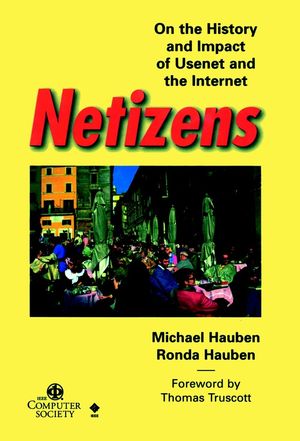Michael Hauben, Ronda Hauben: Netizens: On The History And Impact Of Usenet And The Internet (1996)
Filed under book | Tags: · arpanet, community, computing, history of communications, history of computing, history of technology, internet, media history, netizens, unix, usenet, web

Netizens, one of the first books detailing the Internet, looks at the creation and development of this participatory global computer network. The authors conducted online research to find out what makes the Internet “tick”. This research results in an informative examination of the pioneering vision and actions that have helped make the Net possible. The book is a detailed description of the Net’s construction and a step-by-step view of the past, present, and future of the Internet, the Usenet and the WWW.
The book gives you the needed perspective to understand how the Net can impact the present and the turbulent future. These questions are answered: What is the vision that inspired or guided these people at each step? What was the technical or social problem or need that they were trying to solve? What can be done to help nourish the future extension and development of the Net? How can the Net be made available to a broader set of people?
With foreword by Tom Truscott
A print edition was published by the IEEE Computer Society Press, later distributed by John Wiley
ISBN 0-8186-7706-6
authors
publisher
google books
View online (HTML)
Comment (0)Patrice Flichy: The Internet Imaginaire (2007)
Filed under book | Tags: · 1990s, arpanet, computing, cyberpunk, cyberspace, freenet, history of communications, history of computing, history of technology, internet, networks, technology, usenet, utopia, virtual communities, virtual reality, web, wired

In The Internet Imaginaire, sociologist Patrice Flichy examines the collective vision that shaped the emergence of the Internet—the social imagination that envisioned a technological utopia in the birth of a new technology. By examining in detail the discourses surrounding the development of the Internet in the United States in the 1990s (and considering them an integral part of that development), Flichy shows how an entire society began a new technological era. The metaphorical “information superhighway” became a technical utopia that informed a technological program. The Internet imaginaire, Flichy argues, led software designers, businesses, politicians, and individuals to adopt this one technology instead of another.
Flichy draws on writings by experts—paying particular attention to the gurus of Wired magazine, but also citing articles in Time, Newsweek, and Business Week—from 1991 to 1995. He describes two main domains of the technical imaginaire: the utopias (and ideologies) associated with the development of technical devices and the depictions of an imaginary digital society. He analyzes the founding myths of cyberculture—the representations of technical systems expressing the dreams and experiments of designers and promoters that developed around information highways, the Internet, Bulletin Board systems, and virtual reality. And he offers a treatise on “the virtual society imaginaire,” discussing visionaries from Teilhard de Chardin to William Gibson, the body and the virtual, cyberdemocracy and the end of politics, and the new economy of the immaterial.
Publisher MIT Press, 2007
ISBN 0262062615, 9780262062619
255 pages
PDF (updated on 2012-7-25)
Comment (1)Fred Turner: From Counterculture to Cyberculture. Stewart Brand, the Whole Earth Network and the Rise of Digital Utopianism (2006)
Filed under book | Tags: · collaboration, counterculture, cyberculture, cybernetics, history of communications, history of computing, internet, silicon valley, technology, virtual communities, web, wired

“In the early 1960s, computers haunted the American popular imagination. Bleak tools of the cold war, they embodied the rigid organization and mechanical conformity that made the military-industrial complex possible. But by the 1990s—and the dawn of the Internet—computers started to represent a very different kind of world: a collaborative and digital utopia modeled on the communal ideals of the hippies who so vehemently rebelled against the cold war establishment in the first place.
From Counterculture to Cyberculture is the first book to explore this extraordinary and ironic transformation. Fred Turner here traces the previously untold story of a highly influential group of San Francisco Bay–area entrepreneurs: Stewart Brand and the Whole Earth network. Between 1968 and 1998, via such familiar venues as the National Book Award–winning Whole Earth Catalog, the computer conferencing system known as WELL, and, ultimately, the launch of the wildly successful Wired magazine, Brand and his colleagues brokered a long-running collaboration between San Francisco flower power and the emerging technological hub of Silicon Valley. Thanks to their vision, counterculturalists and technologists alike joined together to reimagine computers as tools for personal liberation, the building of virtual and decidedly alternative communities, and the exploration of bold new social frontiers.
Shedding new light on how our networked culture came to be, this fascinating book reminds us that the distance between the Grateful Dead and Google, between Ken Kesey and the computer itself, is not as great as we might think.”
Publisher University of Chicago Press, 2006
ISBN 0226817415, 9780226817415
x+327+16 pages
Review: Samuel Goëta (Questions de communication, 2013, FR).
PDF (updated 2019-2-25)
Comment (0)
